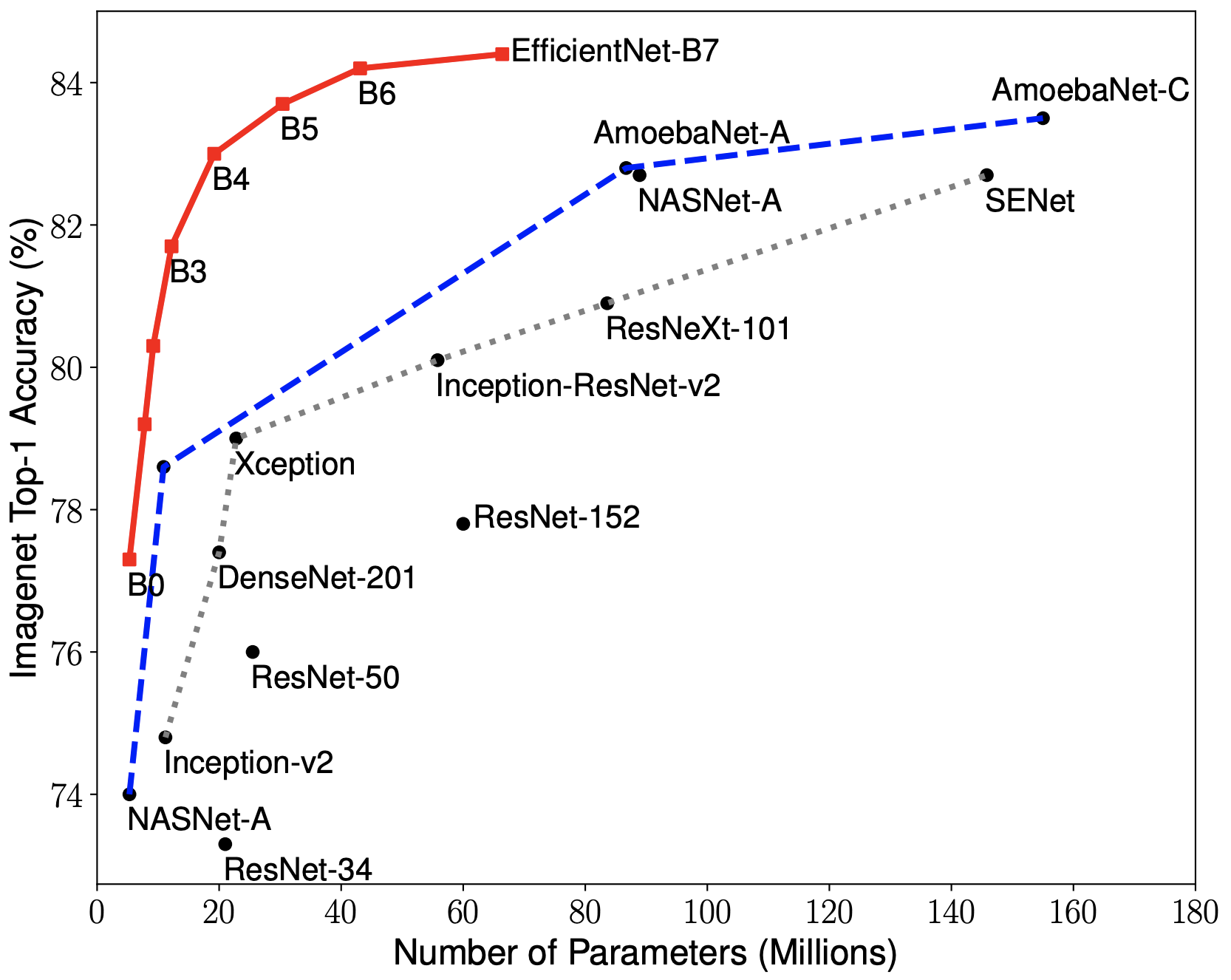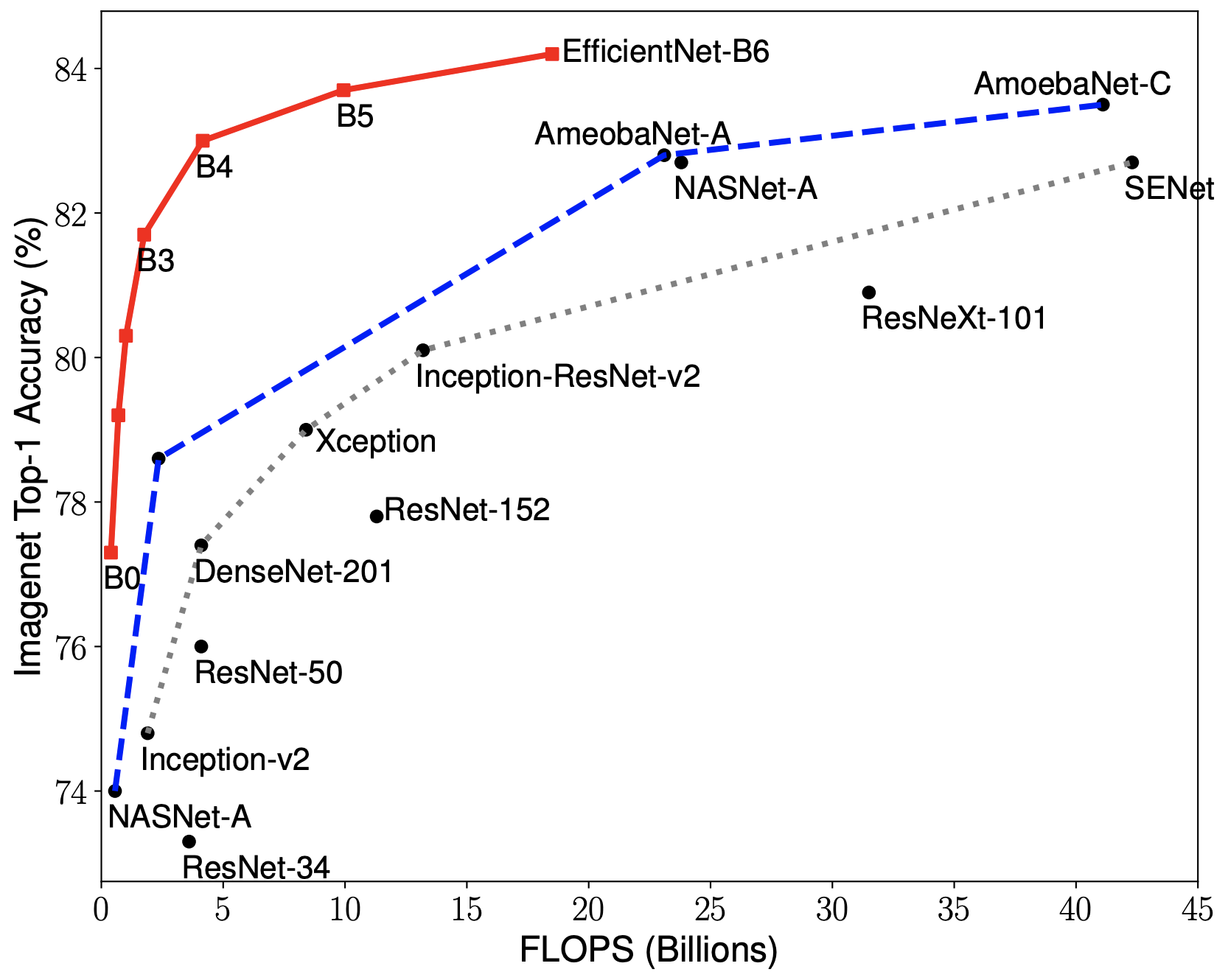Upgrade the pip package with pip install --upgrade efficientnet-pytorch
This update adds easy model exporting (#20) and feature extraction (#38).
- Example: Export to ONNX
- Example: Extract features
- Also: fixed a CUDA/CPU bug (#32)
It is also now incredibly simple to load a pretrained model with a new number of classes for transfer learning:
model = EfficientNet.from_pretrained('efficientnet-b1', num_classes=23)The B4 and B5 models are now available. Their usage is identical to the other models:
from efficientnet_pytorch import EfficientNet
model = EfficientNet.from_pretrained('efficientnet-b4') This repository contains an op-for-op PyTorch reimplementation of EfficientNet, along with pre-trained models and examples.
The goal of this implementation is to be simple, highly extensible, and easy to integrate into your own projects. This implementation is a work in progress -- new features are currently being implemented.
At the moment, you can easily:
- Load pretrained EfficientNet models
- Use EfficientNet models for classification or feature extraction
- Evaluate EfficientNet models on ImageNet or your own images
Upcoming features: In the next few days, you will be able to:
- Train new models from scratch on ImageNet with a simple command
- Quickly finetune an EfficientNet on your own dataset
- Export EfficientNet models for production
If you're new to EfficientNets, here is an explanation straight from the official TensorFlow implementation:
EfficientNets are a family of image classification models, which achieve state-of-the-art accuracy, yet being an order-of-magnitude smaller and faster than previous models. We develop EfficientNets based on AutoML and Compound Scaling. In particular, we first use AutoML Mobile framework to develop a mobile-size baseline network, named as EfficientNet-B0; Then, we use the compound scaling method to scale up this baseline to obtain EfficientNet-B1 to B7.

|

|
EfficientNets achieve state-of-the-art accuracy on ImageNet with an order of magnitude better efficiency:
-
In high-accuracy regime, our EfficientNet-B7 achieves state-of-the-art 84.4% top-1 / 97.1% top-5 accuracy on ImageNet with 66M parameters and 37B FLOPS, being 8.4x smaller and 6.1x faster on CPU inference than previous best Gpipe.
-
In middle-accuracy regime, our EfficientNet-B1 is 7.6x smaller and 5.7x faster on CPU inference than ResNet-152, with similar ImageNet accuracy.
-
Compared with the widely used ResNet-50, our EfficientNet-B4 improves the top-1 accuracy from 76.3% of ResNet-50 to 82.6% (+6.3%), under similar FLOPS constraint.
EfficientNet PyTorch is a PyTorch re-implementation of EfficientNet. It is consistent with the original TensorFlow implementation, such that it is easy to load weights from a TensorFlow checkpoint. At the same time, we aim to make our PyTorch implementation as simple, flexible, and extensible as possible.
If you have any feature requests or questions, feel free to leave them as GitHub issues!
Install via pip:
pip install efficientnet_pytorchOr install from source:
git clone https://github.com/lukemelas/EfficientNet-PyTorch
cd EfficientNet-Pytorch
pip install -e .Load an EfficientNet:
from efficientnet_pytorch import EfficientNet
model = EfficientNet.from_name('efficientnet-b0')Load a pretrained EfficientNet:
from efficientnet_pytorch import EfficientNet
model = EfficientNet.from_pretrained('efficientnet-b0')Note that pretrained models have only been released for N=0,1,2,3,4,5 at the current time, so .from_pretrained only supports 'efficientnet-b{N}' for N=0,1,2,3,4,5.
Details about the models are below:
| Name | # Params | Top-1 Acc. | Pretrained? |
|---|---|---|---|
efficientnet-b0 |
5.3M | 76.3 | ✓ |
efficientnet-b1 |
7.8M | 78.8 | ✓ |
efficientnet-b2 |
9.2M | 79.8 | ✓ |
efficientnet-b3 |
12M | 81.1 | ✓ |
efficientnet-b4 |
19M | 82.6 | ✓ |
efficientnet-b5 |
30M | 83.3 | ✓ |
efficientnet-b6 |
43M | 84.0 | - |
efficientnet-b7 |
66M | 84.4 | - |
Below is a simple, complete example. It may also be found as a jupyter notebook in examples/simple or as a Colab Notebook.
We assume that in your current directory, there is a img.jpg file and a labels_map.txt file (ImageNet class names). These are both included in examples/simple.
import json
from PIL import Image
import torch
from torchvision import transforms
from efficientnet_pytorch import EfficientNet
model = EfficientNet.from_pretrained('efficientnet-b0')
# Preprocess image
tfms = transforms.Compose([transforms.Resize(224), transforms.ToTensor(),
transforms.Normalize([0.485, 0.456, 0.406], [0.229, 0.224, 0.225]),])
img = tfms(Image.open('img.jpg')).unsqueeze(0)
print(img.shape) # torch.Size([1, 3, 224, 224])
# Load ImageNet class names
labels_map = json.load(open('labels_map.txt'))
labels_map = [labels_map[str(i)] for i in range(1000)]
# Classify
model.eval()
with torch.no_grad():
outputs = model(img)
# Print predictions
print('-----')
for idx in torch.topk(outputs, k=5).indices.squeeze(0).tolist():
prob = torch.softmax(outputs, dim=1)[0, idx].item()
print('{label:<75} ({p:.2f}%)'.format(label=labels_map[idx], p=prob*100))You can easily extract features with model.extract_features:
from efficientnet_pytorch import EfficientNet
model = EfficientNet.from_pretrained('efficientnet-b0')
# ... image preprocessing as in the classification example ...
print(img.shape) # torch.Size([1, 3, 224, 224])
features = model.extract_features(img)
print(features.shape) # torch.Size([1, 1280, 7, 7])Exporting to ONNX for deploying to production is now simple:
import torch
from efficientnet_pytorch import EfficientNet
model = EfficientNet.from_pretrained('efficientnet-b1')
dummy_input = torch.randn(10, 3, 240, 240)
torch.onnx.export(model, dummy_input, "test-b1.onnx", verbose=True)Here is a Colab example.
See examples/imagenet for details about evaluating on ImageNet.
If you find a bug, create a GitHub issue, or even better, submit a pull request. Similarly, if you have questions, simply post them as GitHub issues.
I look forward to seeing what the community does with these models!